Funky and Fragile in a Keysie Kind of Way
When friends in Florida invited us to cruise the Keys with them, we were quick to accept their kind offer. We left the Miami airport and traffic congestion behind and stepped aboard their 40-foot Endeavor trawler cat, stowed our gear, and in no time were underway leaving the dock at Key Biscayne. We wound our way through a maze of eye-popping waterfront canal homes leading to the Intracoastal Waterway (ICW) and on to Boca Chita, a picture postcard harbor on the Florida Bay side of the Keys, to spend the night. A stately stone lighthouse welcomes boaters into the harbor that’s part of Biscayne National Park; we followed the channel into the basin and tied up for the night. Only a few boats were there enjoying the quiet and protected harbor.
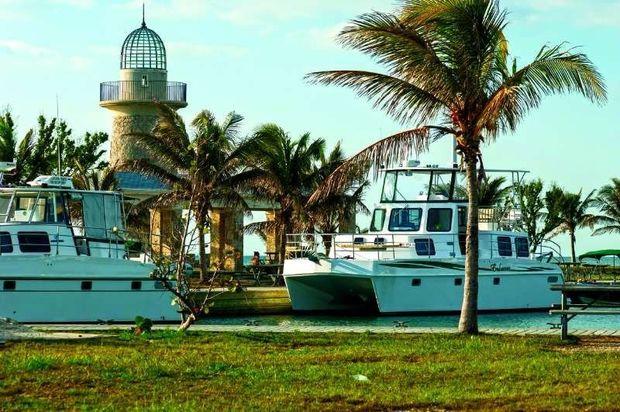
The shadows were getting longer, but there was still time for a short walk to the sandy beach on the ocean side of the island. There we noticed a red dive flag flying off a blue kayak in a small cove. Soon we spotted a diver looking to snare a lobster in the calm waters. On our way back to the boat we followed a walking trail around the island through dense mangroves and dropped $15 in the envelope provided in the pay box (honor system).
We lit charcoals on the grill, uncorked a bottle of red wine, and enjoyed a spectacular sunset as a backdrop. It was hard to believe just hours earlier we were fumbling through airport security in Baltimore.
Boca Chita to Blackwater
The next morning a tour boat arrived complete with park ranger. We tagged along and learned that in the early 1900s when the Upper Florida Keys had several wealthy owners, Boca Chita was bought by Indianan Mark Honeywell of thermostat fame. He wintered in Miami Beach and bought the island as a rural vacation retreat to entertain friends. Some of the limestone buildings remain, but the coral rock lighthouse is the most notable and striking structure. Just 70-odd steps up, there’s a panoramic view in any direction.
The day warmed to 70 degrees with gusty southeast winds for a 30-plus mile run from Boca Chita to Blackwater Sound where we planned to anchor. The first leg of the trip ran through open sounds, but as you approach the narrow mangrove-lined Jewfish Creek, the keys become more intimate. This passage takes you under U.S. Highway 1 called the Overseas Highway, the main and only artery to Key West.
Beyond Jewfish Creek, we were fully immersed in cruising. Our land lives and responsibilities receded, replaced by the more ethereal. Spotting a white heron on the shoreline or a turtle or manatee in the aquamarine water consumed us.
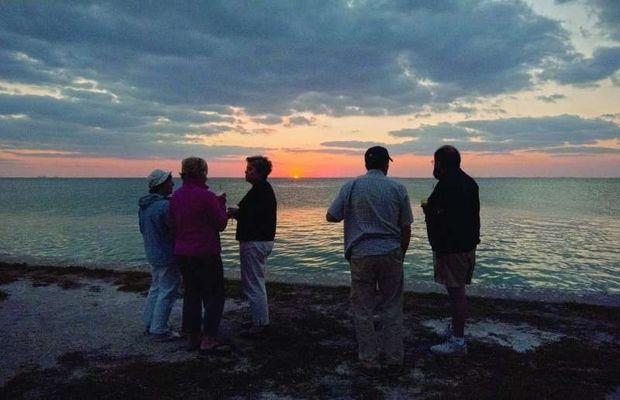
Sometimes it takes a while to become accustomed to new surroundings on a boat, but the design and cruising comforts of the 40-footer made us feel right at home. The sturdy triple lifeline stanchions around the perimeter of the bridge provide a firm grip to move about, and the wide side decks and molded steps made getting around easy. There’s space to entertain a crowd and plenty of seating area on the expansive bridge.
We dropped the hook for the night in Blackwater Sound near the entrance to Dusenbury Creek with protection from low-lying mangroves filled with sea birds. After dinner we all enjoyed a memorable sunset and called it a day.
On to Little Basin
The next morning the buzz of early-bird anglers gave us a wake-up call; we quickly concluded we must be anchored in good fishing grounds by the number of the skiffs and rigs around us.
The water is on the skinny side at Little Basin where Bayside Marina at World Wide Sportsman is located, so we planned to arrive close to high tide and didn’t pull the anchor until after lunch. Once underway, we took the snaky turns and twists of the mangrove-lined Dusenbury channel in stride, happy to find there wasn’t much traffic for such a nice weekend afternoon, but we enjoyed the company of playful dolphins.
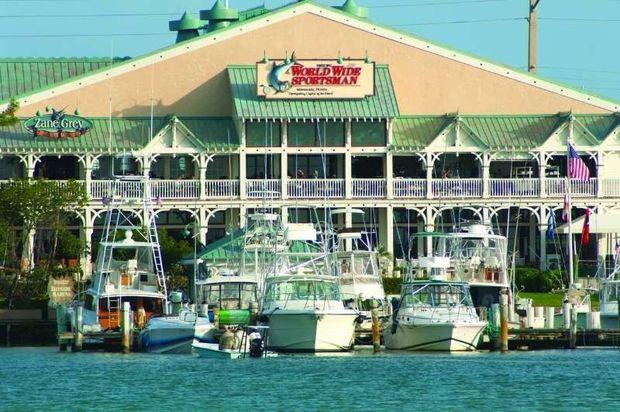
It was another heavenly day in the 70s, but when we reached open water, the wind was blustery and blowing 15-20 miles per hour from the southeast. The waterway zigs and zags through seagrasses and hardwood hammocks and then takes a sharp left and goes starboard approaching the red markers at Tavernier’s Community Harbor.
The challenge of dodging crab or lobster pots to prevent tangling a float line in a propeller is an issue in the Keys. But the shape of the cat’s twin keels provides protection, and a float line (or any debris) slides down the side of the keel and won’t foul the prop. The shape also provides protection when grounding.
A northbound boat flying a bright blue Conch Republic flag passed us and sparked a discussion about the great succession. It seems a gang of Keys’ residents made the nightly news when they “temporarily” seceded from the U.S. in the 1980s. We laughed about the minute-long rebellion followed by their surrender and demand for one billion dollars in foreign aid reminiscent of the satire “The Mouse That Roared.”
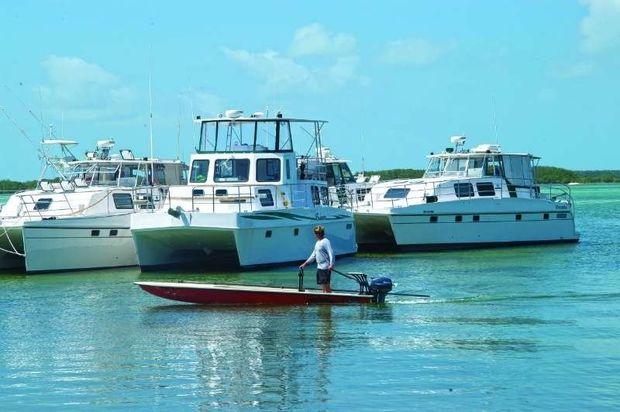
We arrived at Little Basin and eased our way slowly down the channel. The marina complex is a hub of all things fishing with a large charter fleet and retail center on the water. Black and white photos of the smiling faces of fishermen, including a host of presidents and celebrities, line the walls of the two-story building that sells everything from the latest fishing equipment to artwork and clothing. Upstairs the Zane Grey Long Key Lounge offers an enticing menu and panoramic view of the water. Fishing-mania permeates this complex; even the parking lot has a whimsical touch of neat rows of white fish shapes marking parking spaces instead of typical straight lines.
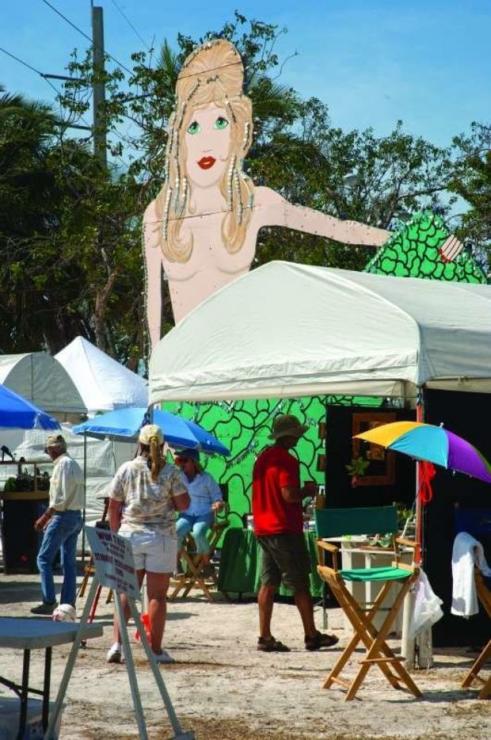 “Keysie” charm
“Keysie” charm
The next day we opted for breakfast at Mangrove Mike’s, a hearty walk north on the highway. On our slow walk back to the boat, we strolled through an impressive exhibit of the Florida Keys Art Guild displaying their work in clusters of white tents staked in a patch of sand on the roadside. We wound our way past a lemon tree, ready to burst with bright yellow fruit, and through a maze of dazzling artwork: watercolors, oils, pastels, wood, and ceramics pieces—with a steel drum group playing soft Bama music in the background.
We took a late afternoon stroll to Lorelei’s, a Keys’ institution; a bar and restaurant on the water with a family of cats meandering about that added to its “Keysie” charm. It was beer o’clock and people were arriving by boat, bike, car, and on foot to find a good spot to celebrate the sunset and listen to rock and reggae music. “Yeh, man, this is eye candy,” we overheard a guy say as he leaned on the bar gazing to the water. It was easy to see how the Keys inspired songs about being Key-wasted by Jimmy Buffett and Jim Morris.
A run to Bahia Honda
The morning greyish skies hinted at rain but developed into white pillow clouds and blue skies for a run to Bahia Honda, a Florida state park just beyond Moser Channel. The shades and hues of the water intrigued us remembering from our sailing days: “blue, blue, run on through; green, green, sailing’s clean and white, white, you just might (run aground).” We used the water color to help read its depth, but relied on the navigation equipment.
We were on the bayside of Marathon paralleling the impressive seven-mile bridge spanning Moser Channel when we passed Pidgeon Key, a five-acre island that’s on the National Register of Historic Places. Originally settled in the 1900s for workers from Henry Flagler’s Overseas Railroad project, the tiny island today features the restored conch-style cottages and dormitories, a research center for the University of Miami, and a site for the U.S. Coast Guard.
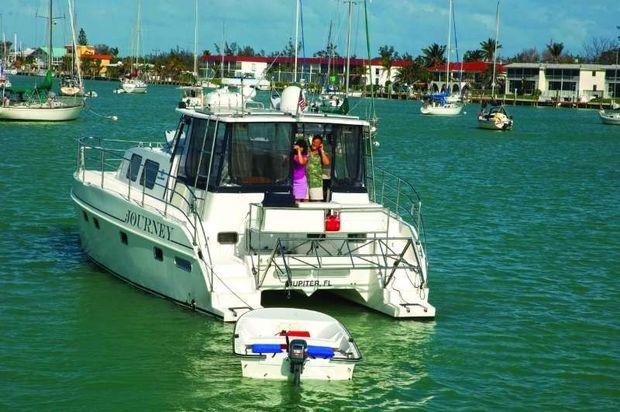
Bahia Honda, known for its long sandy beaches and clear deep waters for swimming and snorkeling, is a 524-acre state park. We turned down the channel and went under the bridge to find a protected anchorage from all but northeasterly winds. You can explore the beach, peek into tide pools, and be close to nature just minutes from your boat. A narrow cut leads inside the basin where boats can tie up, and a concession building has kayaks and snorkeling gear for rent. The park is busy with campers and day visitors going to the beach and riding along bike trails. Boaters and fishermen come and go, and dive boats full of snorkelers head out to the reefs on the ocean side daily. While we were there, volunteers from the University of Florida were helping de-litter the beaches and paint some of the bathhouses.
Signs along the nature trails identify the unique and rare subtropical plants brought here by birds, hurricane winds and ocean waves from the West Indies and Caribbean. Park rangers tell visitors about the history and wildlife in this unusual pristine setting, a gardener’s paradise where silver palm and yellow satinwood trees flourish, and lush crops of sea lavender and Jamaican morning glory thrive.
Boot Key and beyond
It’s a short run into Boot Key Harbor on Vaca Key, the heart of Marathon. We turned to go under the Seven Mile Bridge, the longest segmented bridge in the world, into the Atlantic and headed northeast to enter the harbor channel and calmer water. Marathon is the center of the Keys and clearly the melting pot where boats of all size and description are tied in slips, hang on moorings, or anchor in the protected harbor. A water taxi, city pump out boat, and dinghies made up the harbor traffic. We tied up at the city-operated marina and walked the grounds with a large community park.

We had a farewell dinner with our friends reminiscing about the clear, quiet waters of the Keys and our stretch of good weather to enjoy them. The next day we woke early to the buzz of outboards ferrying worker-bees ashore from the liveaboards in the harbor. We took the On Time taxi to pick up a rental car and then headed north for the Miami Airport. As we crossed the bridge over Jewfish Creek, we marveled at the Keys and their lush tropical environment so pristine and remote, yet so close to Miami. We were immersed in its fragile, yet funky atmosphere, so it was an easy and unanimous decision—cruising in the Keys was definitely to be continued.
About the authors: Katie and Gene Hamilton are authors of three e-books: "Great Loop Cruising: Two on a Trawler," "Cruising the Intracoastal Waterway," and "Lessons Learned Cruising the ICW: Norfolk to Key West" available at
amazon.com.
 The shadows were getting longer, but there was still time for a short walk to the sandy beach on the ocean side of the island. There we noticed a red dive flag flying off a blue kayak in a small cove. Soon we spotted a diver looking to snare a lobster in the calm waters. On our way back to the boat we followed a walking trail around the island through dense mangroves and dropped $15 in the envelope provided in the pay box (honor system).
We lit charcoals on the grill, uncorked a bottle of red wine, and enjoyed a spectacular sunset as a backdrop. It was hard to believe just hours earlier we were fumbling through airport security in Baltimore.
Boca Chita to Blackwater
The next morning a tour boat arrived complete with park ranger. We tagged along and learned that in the early 1900s when the Upper Florida Keys had several wealthy owners, Boca Chita was bought by Indianan Mark Honeywell of thermostat fame. He wintered in Miami Beach and bought the island as a rural vacation retreat to entertain friends. Some of the limestone buildings remain, but the coral rock lighthouse is the most notable and striking structure. Just 70-odd steps up, there’s a panoramic view in any direction.
The day warmed to 70 degrees with gusty southeast winds for a 30-plus mile run from Boca Chita to Blackwater Sound where we planned to anchor. The first leg of the trip ran through open sounds, but as you approach the narrow mangrove-lined Jewfish Creek, the keys become more intimate. This passage takes you under U.S. Highway 1 called the Overseas Highway, the main and only artery to Key West.
Beyond Jewfish Creek, we were fully immersed in cruising. Our land lives and responsibilities receded, replaced by the more ethereal. Spotting a white heron on the shoreline or a turtle or manatee in the aquamarine water consumed us.
The shadows were getting longer, but there was still time for a short walk to the sandy beach on the ocean side of the island. There we noticed a red dive flag flying off a blue kayak in a small cove. Soon we spotted a diver looking to snare a lobster in the calm waters. On our way back to the boat we followed a walking trail around the island through dense mangroves and dropped $15 in the envelope provided in the pay box (honor system).
We lit charcoals on the grill, uncorked a bottle of red wine, and enjoyed a spectacular sunset as a backdrop. It was hard to believe just hours earlier we were fumbling through airport security in Baltimore.
Boca Chita to Blackwater
The next morning a tour boat arrived complete with park ranger. We tagged along and learned that in the early 1900s when the Upper Florida Keys had several wealthy owners, Boca Chita was bought by Indianan Mark Honeywell of thermostat fame. He wintered in Miami Beach and bought the island as a rural vacation retreat to entertain friends. Some of the limestone buildings remain, but the coral rock lighthouse is the most notable and striking structure. Just 70-odd steps up, there’s a panoramic view in any direction.
The day warmed to 70 degrees with gusty southeast winds for a 30-plus mile run from Boca Chita to Blackwater Sound where we planned to anchor. The first leg of the trip ran through open sounds, but as you approach the narrow mangrove-lined Jewfish Creek, the keys become more intimate. This passage takes you under U.S. Highway 1 called the Overseas Highway, the main and only artery to Key West.
Beyond Jewfish Creek, we were fully immersed in cruising. Our land lives and responsibilities receded, replaced by the more ethereal. Spotting a white heron on the shoreline or a turtle or manatee in the aquamarine water consumed us.
 Sometimes it takes a while to become accustomed to new surroundings on a boat, but the design and cruising comforts of the 40-footer made us feel right at home. The sturdy triple lifeline stanchions around the perimeter of the bridge provide a firm grip to move about, and the wide side decks and molded steps made getting around easy. There’s space to entertain a crowd and plenty of seating area on the expansive bridge.
We dropped the hook for the night in Blackwater Sound near the entrance to Dusenbury Creek with protection from low-lying mangroves filled with sea birds. After dinner we all enjoyed a memorable sunset and called it a day.
On to Little Basin
The next morning the buzz of early-bird anglers gave us a wake-up call; we quickly concluded we must be anchored in good fishing grounds by the number of the skiffs and rigs around us.
The water is on the skinny side at Little Basin where Bayside Marina at World Wide Sportsman is located, so we planned to arrive close to high tide and didn’t pull the anchor until after lunch. Once underway, we took the snaky turns and twists of the mangrove-lined Dusenbury channel in stride, happy to find there wasn’t much traffic for such a nice weekend afternoon, but we enjoyed the company of playful dolphins.
Sometimes it takes a while to become accustomed to new surroundings on a boat, but the design and cruising comforts of the 40-footer made us feel right at home. The sturdy triple lifeline stanchions around the perimeter of the bridge provide a firm grip to move about, and the wide side decks and molded steps made getting around easy. There’s space to entertain a crowd and plenty of seating area on the expansive bridge.
We dropped the hook for the night in Blackwater Sound near the entrance to Dusenbury Creek with protection from low-lying mangroves filled with sea birds. After dinner we all enjoyed a memorable sunset and called it a day.
On to Little Basin
The next morning the buzz of early-bird anglers gave us a wake-up call; we quickly concluded we must be anchored in good fishing grounds by the number of the skiffs and rigs around us.
The water is on the skinny side at Little Basin where Bayside Marina at World Wide Sportsman is located, so we planned to arrive close to high tide and didn’t pull the anchor until after lunch. Once underway, we took the snaky turns and twists of the mangrove-lined Dusenbury channel in stride, happy to find there wasn’t much traffic for such a nice weekend afternoon, but we enjoyed the company of playful dolphins.
 It was another heavenly day in the 70s, but when we reached open water, the wind was blustery and blowing 15-20 miles per hour from the southeast. The waterway zigs and zags through seagrasses and hardwood hammocks and then takes a sharp left and goes starboard approaching the red markers at Tavernier’s Community Harbor.
The challenge of dodging crab or lobster pots to prevent tangling a float line in a propeller is an issue in the Keys. But the shape of the cat’s twin keels provides protection, and a float line (or any debris) slides down the side of the keel and won’t foul the prop. The shape also provides protection when grounding.
A northbound boat flying a bright blue Conch Republic flag passed us and sparked a discussion about the great succession. It seems a gang of Keys’ residents made the nightly news when they “temporarily” seceded from the U.S. in the 1980s. We laughed about the minute-long rebellion followed by their surrender and demand for one billion dollars in foreign aid reminiscent of the satire “The Mouse That Roared.”
It was another heavenly day in the 70s, but when we reached open water, the wind was blustery and blowing 15-20 miles per hour from the southeast. The waterway zigs and zags through seagrasses and hardwood hammocks and then takes a sharp left and goes starboard approaching the red markers at Tavernier’s Community Harbor.
The challenge of dodging crab or lobster pots to prevent tangling a float line in a propeller is an issue in the Keys. But the shape of the cat’s twin keels provides protection, and a float line (or any debris) slides down the side of the keel and won’t foul the prop. The shape also provides protection when grounding.
A northbound boat flying a bright blue Conch Republic flag passed us and sparked a discussion about the great succession. It seems a gang of Keys’ residents made the nightly news when they “temporarily” seceded from the U.S. in the 1980s. We laughed about the minute-long rebellion followed by their surrender and demand for one billion dollars in foreign aid reminiscent of the satire “The Mouse That Roared.”
 We arrived at Little Basin and eased our way slowly down the channel. The marina complex is a hub of all things fishing with a large charter fleet and retail center on the water. Black and white photos of the smiling faces of fishermen, including a host of presidents and celebrities, line the walls of the two-story building that sells everything from the latest fishing equipment to artwork and clothing. Upstairs the Zane Grey Long Key Lounge offers an enticing menu and panoramic view of the water. Fishing-mania permeates this complex; even the parking lot has a whimsical touch of neat rows of white fish shapes marking parking spaces instead of typical straight lines.
We arrived at Little Basin and eased our way slowly down the channel. The marina complex is a hub of all things fishing with a large charter fleet and retail center on the water. Black and white photos of the smiling faces of fishermen, including a host of presidents and celebrities, line the walls of the two-story building that sells everything from the latest fishing equipment to artwork and clothing. Upstairs the Zane Grey Long Key Lounge offers an enticing menu and panoramic view of the water. Fishing-mania permeates this complex; even the parking lot has a whimsical touch of neat rows of white fish shapes marking parking spaces instead of typical straight lines.
 “Keysie” charm
The next day we opted for breakfast at Mangrove Mike’s, a hearty walk north on the highway. On our slow walk back to the boat, we strolled through an impressive exhibit of the Florida Keys Art Guild displaying their work in clusters of white tents staked in a patch of sand on the roadside. We wound our way past a lemon tree, ready to burst with bright yellow fruit, and through a maze of dazzling artwork: watercolors, oils, pastels, wood, and ceramics pieces—with a steel drum group playing soft Bama music in the background.
We took a late afternoon stroll to Lorelei’s, a Keys’ institution; a bar and restaurant on the water with a family of cats meandering about that added to its “Keysie” charm. It was beer o’clock and people were arriving by boat, bike, car, and on foot to find a good spot to celebrate the sunset and listen to rock and reggae music. “Yeh, man, this is eye candy,” we overheard a guy say as he leaned on the bar gazing to the water. It was easy to see how the Keys inspired songs about being Key-wasted by Jimmy Buffett and Jim Morris.
A run to Bahia Honda
The morning greyish skies hinted at rain but developed into white pillow clouds and blue skies for a run to Bahia Honda, a Florida state park just beyond Moser Channel. The shades and hues of the water intrigued us remembering from our sailing days: “blue, blue, run on through; green, green, sailing’s clean and white, white, you just might (run aground).” We used the water color to help read its depth, but relied on the navigation equipment.
We were on the bayside of Marathon paralleling the impressive seven-mile bridge spanning Moser Channel when we passed Pidgeon Key, a five-acre island that’s on the National Register of Historic Places. Originally settled in the 1900s for workers from Henry Flagler’s Overseas Railroad project, the tiny island today features the restored conch-style cottages and dormitories, a research center for the University of Miami, and a site for the U.S. Coast Guard.
“Keysie” charm
The next day we opted for breakfast at Mangrove Mike’s, a hearty walk north on the highway. On our slow walk back to the boat, we strolled through an impressive exhibit of the Florida Keys Art Guild displaying their work in clusters of white tents staked in a patch of sand on the roadside. We wound our way past a lemon tree, ready to burst with bright yellow fruit, and through a maze of dazzling artwork: watercolors, oils, pastels, wood, and ceramics pieces—with a steel drum group playing soft Bama music in the background.
We took a late afternoon stroll to Lorelei’s, a Keys’ institution; a bar and restaurant on the water with a family of cats meandering about that added to its “Keysie” charm. It was beer o’clock and people were arriving by boat, bike, car, and on foot to find a good spot to celebrate the sunset and listen to rock and reggae music. “Yeh, man, this is eye candy,” we overheard a guy say as he leaned on the bar gazing to the water. It was easy to see how the Keys inspired songs about being Key-wasted by Jimmy Buffett and Jim Morris.
A run to Bahia Honda
The morning greyish skies hinted at rain but developed into white pillow clouds and blue skies for a run to Bahia Honda, a Florida state park just beyond Moser Channel. The shades and hues of the water intrigued us remembering from our sailing days: “blue, blue, run on through; green, green, sailing’s clean and white, white, you just might (run aground).” We used the water color to help read its depth, but relied on the navigation equipment.
We were on the bayside of Marathon paralleling the impressive seven-mile bridge spanning Moser Channel when we passed Pidgeon Key, a five-acre island that’s on the National Register of Historic Places. Originally settled in the 1900s for workers from Henry Flagler’s Overseas Railroad project, the tiny island today features the restored conch-style cottages and dormitories, a research center for the University of Miami, and a site for the U.S. Coast Guard.
 Bahia Honda, known for its long sandy beaches and clear deep waters for swimming and snorkeling, is a 524-acre state park. We turned down the channel and went under the bridge to find a protected anchorage from all but northeasterly winds. You can explore the beach, peek into tide pools, and be close to nature just minutes from your boat. A narrow cut leads inside the basin where boats can tie up, and a concession building has kayaks and snorkeling gear for rent. The park is busy with campers and day visitors going to the beach and riding along bike trails. Boaters and fishermen come and go, and dive boats full of snorkelers head out to the reefs on the ocean side daily. While we were there, volunteers from the University of Florida were helping de-litter the beaches and paint some of the bathhouses.
Signs along the nature trails identify the unique and rare subtropical plants brought here by birds, hurricane winds and ocean waves from the West Indies and Caribbean. Park rangers tell visitors about the history and wildlife in this unusual pristine setting, a gardener’s paradise where silver palm and yellow satinwood trees flourish, and lush crops of sea lavender and Jamaican morning glory thrive.
Boot Key and beyond
It’s a short run into Boot Key Harbor on Vaca Key, the heart of Marathon. We turned to go under the Seven Mile Bridge, the longest segmented bridge in the world, into the Atlantic and headed northeast to enter the harbor channel and calmer water. Marathon is the center of the Keys and clearly the melting pot where boats of all size and description are tied in slips, hang on moorings, or anchor in the protected harbor. A water taxi, city pump out boat, and dinghies made up the harbor traffic. We tied up at the city-operated marina and walked the grounds with a large community park.
Bahia Honda, known for its long sandy beaches and clear deep waters for swimming and snorkeling, is a 524-acre state park. We turned down the channel and went under the bridge to find a protected anchorage from all but northeasterly winds. You can explore the beach, peek into tide pools, and be close to nature just minutes from your boat. A narrow cut leads inside the basin where boats can tie up, and a concession building has kayaks and snorkeling gear for rent. The park is busy with campers and day visitors going to the beach and riding along bike trails. Boaters and fishermen come and go, and dive boats full of snorkelers head out to the reefs on the ocean side daily. While we were there, volunteers from the University of Florida were helping de-litter the beaches and paint some of the bathhouses.
Signs along the nature trails identify the unique and rare subtropical plants brought here by birds, hurricane winds and ocean waves from the West Indies and Caribbean. Park rangers tell visitors about the history and wildlife in this unusual pristine setting, a gardener’s paradise where silver palm and yellow satinwood trees flourish, and lush crops of sea lavender and Jamaican morning glory thrive.
Boot Key and beyond
It’s a short run into Boot Key Harbor on Vaca Key, the heart of Marathon. We turned to go under the Seven Mile Bridge, the longest segmented bridge in the world, into the Atlantic and headed northeast to enter the harbor channel and calmer water. Marathon is the center of the Keys and clearly the melting pot where boats of all size and description are tied in slips, hang on moorings, or anchor in the protected harbor. A water taxi, city pump out boat, and dinghies made up the harbor traffic. We tied up at the city-operated marina and walked the grounds with a large community park.
 We had a farewell dinner with our friends reminiscing about the clear, quiet waters of the Keys and our stretch of good weather to enjoy them. The next day we woke early to the buzz of outboards ferrying worker-bees ashore from the liveaboards in the harbor. We took the On Time taxi to pick up a rental car and then headed north for the Miami Airport. As we crossed the bridge over Jewfish Creek, we marveled at the Keys and their lush tropical environment so pristine and remote, yet so close to Miami. We were immersed in its fragile, yet funky atmosphere, so it was an easy and unanimous decision—cruising in the Keys was definitely to be continued.
About the authors: Katie and Gene Hamilton are authors of three e-books: "Great Loop Cruising: Two on a Trawler," "Cruising the Intracoastal Waterway," and "Lessons Learned Cruising the ICW: Norfolk to Key West" available at amazon.com.
We had a farewell dinner with our friends reminiscing about the clear, quiet waters of the Keys and our stretch of good weather to enjoy them. The next day we woke early to the buzz of outboards ferrying worker-bees ashore from the liveaboards in the harbor. We took the On Time taxi to pick up a rental car and then headed north for the Miami Airport. As we crossed the bridge over Jewfish Creek, we marveled at the Keys and their lush tropical environment so pristine and remote, yet so close to Miami. We were immersed in its fragile, yet funky atmosphere, so it was an easy and unanimous decision—cruising in the Keys was definitely to be continued.
About the authors: Katie and Gene Hamilton are authors of three e-books: "Great Loop Cruising: Two on a Trawler," "Cruising the Intracoastal Waterway," and "Lessons Learned Cruising the ICW: Norfolk to Key West" available at amazon.com.